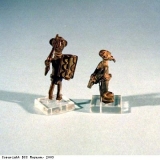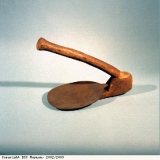Slavery in Africa
Slavery existed in Africa, but it was not the same type of slavery that the Europeans introduced. The European form was called chattel slavery. A chattel slave is a piece of property, with no rights. Slavery within Africa was different. A slave might be enslaved in order to pay off a debt or pay for a crime. Slaves in Africa lost the protection of their family and their place in society through enslavement. But eventually they or their children might become part of their master’s family and become free. This was unlike chattel slavery, in which enslaved Africans were slaves for life, as were their children and grandchildren.
The treatment of slaves in Africa varied widely. Ottobah Cuguano, a former slave, remembered slaves as being ‘well fed … and treated well’. Olaudah Equiano, another former slave who wrote an account of his life, noted that slaves might even own slaves themselves. In larger states some slaves worked in government administration, and might become an important state or royal official with wide ranging powers. Other slaves in Africa might work within their master’s household as domestic servants or as agricultural labourers. Others were sent to work in the gold mines of West Africa. Pictured here are two weights in the shape of a soldier and captive. They were used to weigh gold dust, which was itself used as a type of money. Mining for gold was hard and dangerous work, and many died.
Africans usually enslaved ‘other’ people, not their own particular ethnic, or cultural, group. Slaves were taken as prisoners of war, or enslaved in payment for debt or as punishment for crime. This enslavement was usually on a small scale. It was enough to supply the demand for slaves within Africa, but not enough to supply the demand from outside. As the demand from outsiders such as Arabs and Europeans grew, warfare and raids to get slaves and the kidnapping of individuals increased. Europeans wanted to buy enslaved Africans to work on the land they owned on the Caribbean islands and in America. They chose Africans for a number of reasons, one being because they were used to farming. Pictured here is a 20th century hoe, a tool used to work the soil. It is from the Igbo people of Nigeria, West Africa.




